Original / Odaily Planet Daily
Author / Golem
At 1 AM on August 7, the much-anticipated Bitcoin expansion plan, the RGB protocol, finally went live on the mainnet. To encourage users to experience the RGB protocol on the mainnet, the infrastructure developer Bitlight Labs also launched the test currency RGB on the mainnet. Users can claim RGB from the faucet on the Bitlight Labs official website.
Although RGB is just a test currency, it is essentially the first RGB asset on the Bitcoin mainnet and occupies a symbolically significant token name. Therefore, within 24 hours before the RGB protocol went live on the mainnet, tutorials for listing and FOMO emotions spread widely. Degen enthusiasts were rubbing their hands in anticipation in the dark, and a tough battle was probably unavoidable.
However, when the RGB protocol truly went live, FOMO immediately turned into FUD. Even now, the progress of the RGB token listing is less than 20%. What led to this change? Is it still worth participating in the RGB protocol? Odaily Planet Daily will briefly analyze this in this article.
Review RGB protocol
The RGB protocol became one of the hottest smart contract expansion plans amidst the Bitcoin ecosystem boom in 2023, but it is also one of the slowest developing expansion plans. Conceived in 2016, formally developed in 2019, the development work changed hands several times. In 2023, due to the strong market demand for Bitcoin expansion, it was brought back into focus, but the progress of development remained slow. In 2024, the RGB++ protocol successfully took the lead by leveraging this popularity, but the RGB++ protocol also could not escape the fate of decline. The real acceleration of progress only came in 2024 after the Bitlight Labs team assisted in RGB development. After a long journey of five years, it has finally launched on the mainnet.
As time wears on, for most users, the long development time, excellent team background, obscure complexity, and deep research reports of several thousand words may be the only remaining impressions of the RGB protocol. These impressions have condensed into the phrase 'awesome' in their minds, which is why there was such a large-scale discussion and preparation before the mainnet launch. Therefore, I believe it is necessary to briefly introduce the key points of the RGB protocol in this article.
One-time seal
For the Bitcoin network, the RGB protocol is an off-chain expansion plan that keeps smart contracts and transaction data off-chain, thus inherently possessing Turing completeness while using the Bitcoin mainnet as a 'security endorsement.'
An important technology in the RGB protocol is the one-time seal, which ensures that the same information can only be used once. The UTXO model of the Bitcoin network is inherently compatible with this technology, as each UTXO can only be used once. By encrypting and encapsulating RGB asset information and contract status within the UTXO, these UTXOs are referred to as containers. When a UTXO is spent, the ownership of the asset and the contract status change, effectively preventing double spending and ensuring the security of the RGB ledger.
Client verification
Another important technology of the RGB protocol is client verification. The transfer of RGB assets is not broadcast via the Bitcoin mainnet but is conducted by independent off-chain clients. Therefore, whenever a transaction occurs, the client only needs to verify if the status related to this transaction is correct, without needing to synchronize and verify all transactions across the entire network, which enhances the protection of privacy to a certain extent.
The above outlines two important technologies of how the RGB protocol conducts asset transfer and ensures security. As for how to write smart contracts off-chain and the pros and cons of the methods used compared to EVM, that is not the focus for users.
How to list the first RGB token on the mainnet
The RGB protocol may be complex in principle, but the operation of the new listing activity on the mainnet is very simple. Essentially, it is an airdrop distribution model where users transfer funds to the project party, and then the project party distributes RGB tokens to users in order. Due to the lock mode adopted, the same wallet cannot claim again until the distribution is complete, effectively avoiding network congestion.
As of now, the total amount of RGB tokens is 21 million, with each claim limited to only 50 tokens and slow distribution, the claiming progress is less than 20%. The community calculates that according to the Bitcoin network's block speed, it will take at least 17 hours to complete. Therefore, everyone still has a chance. Below is the specific tutorial for the new listing.
Create Bitlight wallet and transfer BTC
First, download the Bitlight plugin wallet, then create a new wallet, and transfer 0.0003-0.0005 BTC from other addresses to the wallet. You don’t need too much. It’s best not to choose to import an old wallet to avoid asset loss due to compatibility issues with various wallet asset protocols.
Create container
Then we need to create RGB UTXO, which is the container for storing RGB assets. First, click on 'UTXOs' in the wallet, as shown below.
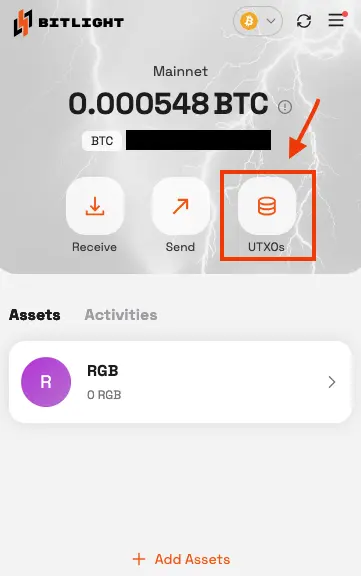
Then click the 'Create UTXO' button in the upper right corner.
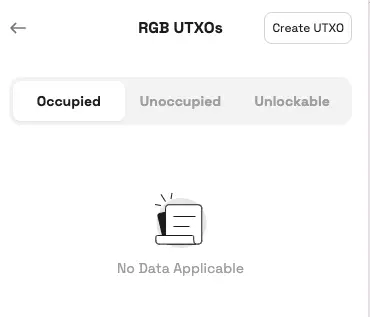
Click 'Custom' to customize the amount of Bitcoin contained in the UTXO. Since this UTXO exists as a container for RGB assets, it doesn't require too much Bitcoin; 0.0001 BTC is sufficient. Then select a suitable fee rate, click next, and the signature is complete.
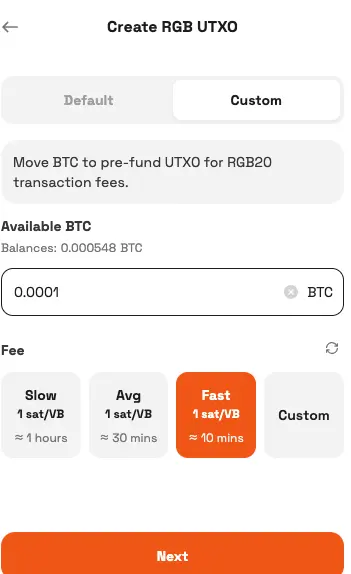
It is recommended not to create too many containers in succession, as creating containers requires paying Bitcoin network gas fees, and unlocking containers (turning them into normally usable UTXOs) also requires gas. Moreover, since this new listing adopts a lock mode and the distribution speed is very slow, for single numbers, creating multiple UTXOs in advance is not very meaningful and may increase costs instead.
Claim RGB tokens
However, after the transaction for creating the container is confirmed, go to the Bitlight official website, link your wallet, and click Claim. As shown below, once a wallet has claimed, the user cannot continue operating and must wait until 'Claiming' is completed before proceeding to the next claim.
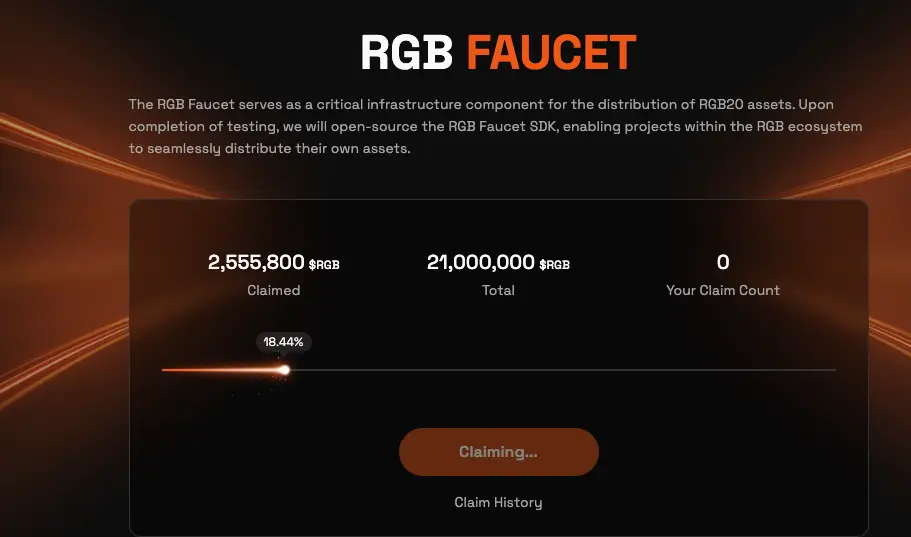
From FOMO to FUD
The new listing activity of RGB on the mainnet is actually quite smooth, but it still faced strong FUD from the community. The reasons are as follows:
The quantity of RGB that can be minted at one time is too small
The total amount of RGB tokens is 21 million, and the project party strictly stipulates that each Claim only distributes 50 tokens. Therefore, it requires 420,000 transactions to fully distribute the RGB tokens. Even if we calculate with 4,000 transactions per block, it will still take 105 blocks to complete, about 17.5 hours.
As a result, the community has criticized the project party for stretching the timeline too long, draining the market's emotions and enthusiasm.
Project party charges
Another reason for FUD around RGB is the charges from Bitlight Labs. According to on-chain information, every Claim transaction from users requires transferring 0.00003636 BTC (approximately $4) to a fixed address. Therefore, for 420,000 claims, the project party can collect about $1.68 million.

A Claim transaction for RGB tokens
Although the project party ultimately explained that these fees would cover future transaction costs for distributing RGB assets and be used for market making and buybacks, planning is just planning, and collecting money is a fact. Many players still find it hard to believe the project party.
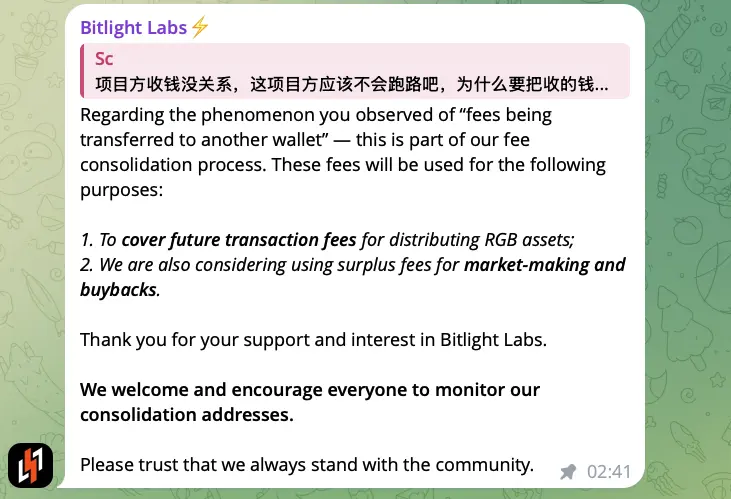
Moreover, the cost of $1.68 million plus the gas fees for users to create containers and transactions means that, based on cost estimation, the market value of the first RGB token has already been raised to around $2 million. Given the current capital stock and popularity of the Bitcoin ecosystem, $2 million is not a low valuation. This may be the true reason behind most players' FUD.
In conclusion
The attention drawn by the RGB protocol this time surprised me. In addition to the familiar faces always at the forefront of 'losing money in new Bitcoin protocols', many users who usually don't pay much attention to the Bitcoin ecosystem also participated.
Recently, the Bitcoin ecosystem has been lively again, starting a wave of new protocol entrepreneurship. From spark, BRC 2.0, rune 2.0, labitu to the current RGB, you may not be familiar with some of these, but there's no need to worry; you might just be missing out on a money-losing opportunity.
New protocols are emerging one after another, each burdened with old yet grand narratives. But the fact is, most projects remain stuck in early concepts or airdrop parties, with very few truly landing. The vitality of innovation is certainly important, but today's pace feels more like a high-speed industrial assembly line.
The player community remains unchanged, flooding into one after another 'new protocol carnival' time and again. Wealth is harvested and circulated among this group, resembling a subculture formed by a group that is not mainstream but united by a common belief and passion for the intertwining of technology and gambling.
In today's world where Bitcoin is already well-known, how can we not call it magical to think that there are still people who entertain themselves within it?

